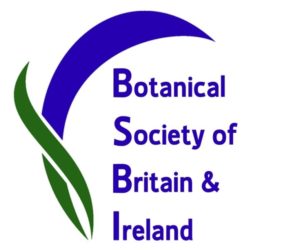Kirkcudbrightshire Botany Group, Urr Water, Glaisters Bridge and Glaisters 11/05/2019
Urr Water, Glaisters Bridge and Glaisters 11th May 2019
Despite a change in the weather, 7 of us assembled at Corsock before driving up to the first monad at Glaisters Bridge (NX7580). I thought we might get some distance away from the parked cars, but the whole morning was spent within 400 metres of the vehicles, including lunch there. This was partly because of the unexpected richness of the site, both in terms of aquatics and its narrow strip of more or less neutral grassland, and the surrounding mire/moorland.
The aquatics included numerous flowering clumps of a water crowfoot, which on home examination turned out to be the relatively common (for VC73) Ranunculus aquatilis.
This was accompanied by similar clumps of Alternate Water-milfoil Myriophyllum alterniflorum, scattered areas of the aquatic moss Fontinalis aquaticus, and a small patch of a unidentified stonewort (Charophyte). Further guddling around in the shallow water produced Hemlock Water Dropwort Oenanthe crocata – all parts poisonous to cattle; fronds of the Long-stalked Pondweed Potamogeton praelongus with its wavy-edged lanceolate leaves; the Pedunculate Water-starwort with two different leaves (linear submerged and oval floating) Callitriche brutia subsp. hamulata; the long linear floating leaves of the Floating Bur-reed Sparganium angustifolium and a small clump of the Shoreweed Littorella uniflora. The shoreline muddy patches supported the shiny-leaved Celery-leaved Buttercup Ranunculus sceleratus, and the narrowly ovate leaves of Lesser Spearwort (another buttercup) R. flammula. The bridge gave us three ferns:Wall Rue Asplenium ruta-muraria, Hart’s Tongue A. scolopendrium and Maidenhair Spleenwort A. trichomanes.
The wetter grassland provided frequent bright green finely divided leaves of Whorled Caraway Carum verticillatum; two violets, Marsh Violet Viola palustris with its rounded leaves and Common Dog-violet V. riviniana with its heart-shaped leaves; Bugle Ajuga retans with its glossy dark green leaves and stolons; and finally a few early shoots of Fairy Flax Linum catharticum and both Imperforate and Slender St John’s Wort Hypericum maculatum and H. pulchrum. There were also numerous flowering spikes of the Field Wood-rush (not a rush, this species has long hairs on its leaves and stem) Luzula campestris.
Between that habitat and the mire/moorland we added 9 sedges, including Spring Sedge Carex caryophyllea, Glaucous Sedge C. flacca, Carnation Sedge C. panicea, Pill Sedge C. pilulifera, Star Sedge C. echinata and Common Sedge C. nigra and the compact or diffuse heads of both subspecies of Heath Wood-rush Luzula multiflora. Meadowsweet was frequent in these two areas, but the mire also had Common Valerian Valeriana officinalis; Ragged Robin Silene flos-cuculi recognisable with its strap-like leaves from a deep red stem; the puce-coloured flowers of Bitter Vetch Lathyrus linifolius; the single white flower head of Hare’s-tail Cotton-grass Eriophorum vaginatum and scattered upright shoots of Creeping Willow Salix repens.
After that we moved to the second monad (NX7679) – in a different tetrad – which was grassland, some improved, some almost unimproved. Here we were expecting to record the Nationally Scarce Spignel Meum athamanticum, which we did surprisingly easily and quickly, on the almost untouched knowes. At least 40 individuals, possibly more as it was uncertain where one plant ended and another began, scattered over about 7 knowes.
The grassland was liberally scattered with the semi-parasitic Yellow Rattle Rhinanthus minor and Pignut Conopodium majus was also frequent. There was scattered Lady’s Bedstraw Galium verum. The riverside produced Wood Anemone Anemone nemorosa; Marsh Hawksbeard Crepis paludosa with its stem-clasping leaves; both Yellow Vetchling Lathyrus pratensis with its large curiously shaped stipules and Bitter Vetch L. linifolius with long linear leaflets. Wood horsetail Equisetum sylvaticum with its bright green drooping branches occurred under a willow stand beside the burn.
There were also sedges, but this time only 5 – the first four in the list above, plus Green-ribbed Sedge Carex binervis. The burn was almost devoid of aquatic species except for Hemlock Water-dropwort O. crocata. In all, this monad contained 100 species. The highlight, of this monad and the day, being the spignel. It’s a VC73 speciality, only matched (possibly?) by the Perthshire populations!
David Hawker
BSBI county recorder for Kirkcudbrightshire VC73

